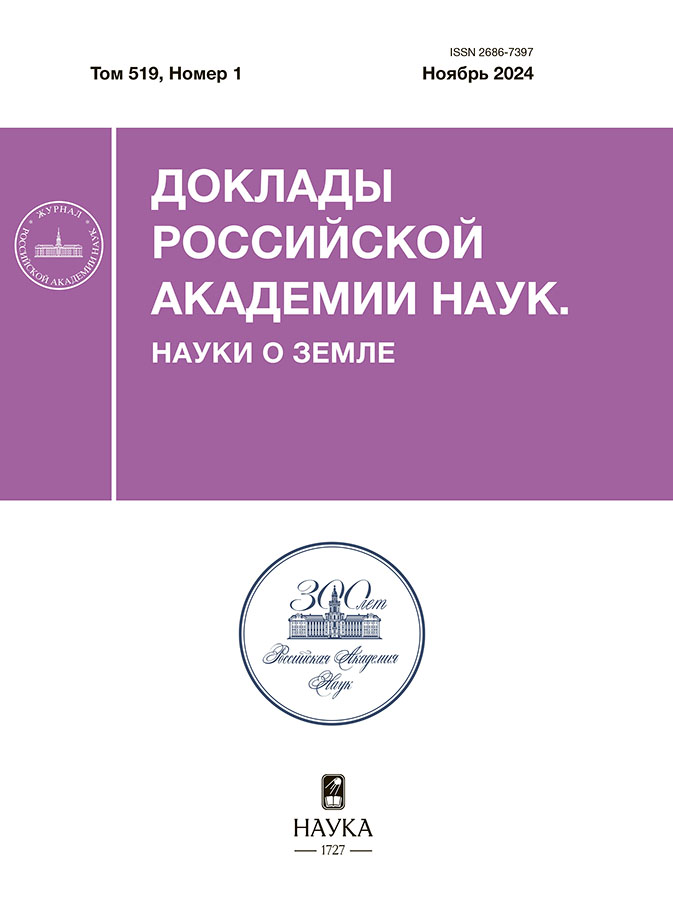Unusual ore mineralization of siliceous rocks of the south-kambalny central thermal field (kamchatka)
- Authors: Palyanova G.A.1, Rychagov S.N.2, Svetova E.N.3, Moroz T.N.1, Seryotkin Y.V.1, Sandimirova E.I.2, Bortnikov N.S.4
-
Affiliations:
- V.S. Sobolev Institute of Geology and Mineralogy of the Russian Academy of Sciences
- Institute of Volcanology and Seismology of the Russian Academy of Sciences
- Institute of Geology of the Federal Research Center “Karelian Scientific Center RAS”
- Institute of Geology of Ore Deposits, Petrography, Mineralogy and Geochemistry of the Russian Academy of Sciences
- Issue: Vol 519, No 1 (2024)
- Pages: 464-473
- Section: MINERALOGY
- Submitted: 04.06.2025
- Published: 20.12.2024
- URL: https://jdigitaldiagnostics.com/2686-7397/article/view/682432
- DOI: https://doi.org/10.31857/S2686739724110108
- ID: 682432
Cite item
Abstract
Samples of siliceous rocks of the South Kambalny Central Thermal Field (SKC), containing unique ore mineralization, were studied. Optical microscopy, scanning electron microscopy, X-ray microanalysis, X-ray phase analysis, ICP-MS and Raman spectroscopy were used for the study. High concentrations and a wide range of rare and rare earth elements have been found in siliceous rocks. Silicaminerals (quartz, moganite, cristobalite tridymite opal), oxides (hematite, anatase), hydroxides (goethite), carbonates (calcite with Fe and Mn impurities), sulfates (barite with Sr impurities, gypsum), sulfides (pyrite, marcasite, chalcopyrite, chalcocite), phosphates (xenotime-Y, YPO4 with impurities of lanthanides, S, Ca and As; aluminophosphate, AlPO4 with impurities of V) and apatite have been identified. Structures of anatase replacement by quartz often in association with pyrite have been identified. The mineralization of siliceous rocks of the SKC reflects the physicochemical specificity of deep metal-bearing solutions.
Full Text
About the authors
G. A. Palyanova
V.S. Sobolev Institute of Geology and Mineralogy of the Russian Academy of Sciences
Author for correspondence.
Email: palyan@igm.nsc.ru
Russian Federation, Novosibirsk
S. N. Rychagov
Institute of Volcanology and Seismology of the Russian Academy of Sciences
Email: palyan@igm.nsc.ru
Russian Federation, Petropavlovsk-Kamchatsky
E. N. Svetova
Institute of Geology of the Federal Research Center “Karelian Scientific Center RAS”
Email: palyan@igm.nsc.ru
Russian Federation, Petrozavodsk
T. N. Moroz
V.S. Sobolev Institute of Geology and Mineralogy of the Russian Academy of Sciences
Email: palyan@igm.nsc.ru
Russian Federation, Novosibirsk
Yu. V. Seryotkin
V.S. Sobolev Institute of Geology and Mineralogy of the Russian Academy of Sciences
Email: palyan@igm.nsc.ru
Russian Federation, Novosibirsk
E. I. Sandimirova
Institute of Volcanology and Seismology of the Russian Academy of Sciences
Email: palyan@igm.nsc.ru
Academician of the RAS
Russian Federation, Petropavlovsk-KamchatskyN. S. Bortnikov
Institute of Geology of Ore Deposits, Petrography, Mineralogy and Geochemistry of the Russian Academy of Sciences
Email: palyan@igm.nsc.ru
Russian Federation, Moscow
References
- Рычагов С.Н., Кравченко О.В., Нуждаев А.А., Чернов М.С., Карташева Е.В., Кузьмина А.А. Южно-Камбальное Центральное термальное поле: структурное положение, гидрогеохимические и литологические характеристики / Вулканизм и связанные с ним процессы, Мат. XXIII научной конф., посвященной Дню вулканолога. Петропавловск-Камчатский. 2020. С. 198–201. http://www.kscnet.ru/ivs/lgt/wp-content/uploads/2020/12/art51.pdf
- Нуждаев И.А., Рычагов С.Н., Феофилактов С.О., Денисов Д.К. Особенности магнитного поля геотермальных систем Паужетского района (Южная Камчатка) // Вулканология и сейсмология. 2023.№ 2. С. 33–51. https://doi.org/10.31857/S0203030622060049.
- Рычагов С.Н., Сандимирова Е.И., Чернов М.С., Кравченко О.В., Карташева Е.В. Состав, строение и происхождение карбонатных конкреций Южно-Камбального Центрального термальногополя (Камчатка) // Вулканология и сейсмология. 2021. № 4. С. 45–60. https://doi.org/10.31857/S0203030621040052
- Götze J., Nasdala L., Kleeberg R., Wenzel M. Occurrence and distribution of “moganite” in agate/chalcedony: A combined micro-Raman, Rietveld, and cathodoluminescence study // Contrib. Mineral. Petrol. 1998. № 133. P. 96–105.
- Светов С.А., Степанова А.В., Бурдюх С.В., Парамонов А.С., Утицына В.Л., Эхова М.В., Теслюк И.А., Чаженгина С.Ю., Светова Е.Н., Конышев А.А. Прецизионный ICP-MS анализ докембрийских горных пород: методика и оценка точности результатов // Труды КарНЦ РАН. 2023. № 2. С. 73–86. https://doi.org/10.17076/geo1755
- Kingma K.J., Hemley R.J. Raman spectroscopic study of microcrystalline quartz // American Mineralogist. 1994. № 79. P. 269–273.
- Gracia L., Beltrán A., Errandonea D. CharacterizationoftheTiSiO4 structureanditspressure-inducedphasetransformations: Density functional theory study // Physical Review. 2009. B 80. 094105. https://doi.org/10.1103/PhysRevB.80.094105
- Кириллова С.А., Альмяшев В.И., Гусаров В.В. Спинодальный распад в системе SiO2–TiO2 и формирование иерархически организованных наноструктур // Наносистемы: Физика, Химия, Математика. 2012. 3 (2). С.100–115.
- Ricker R. W., Hummel A. Reactions in the System TiO2–SiO2; Revision of the Phase Diagram // Journal of the American Ceramic Society. 1951. 34(9). P. 271–279. https://doi.org/10.1111/j.1151-2916.1951.tb09129.x
- Lee J.G., Pickard C.J., Cheng B. High-pressure phase behaviors of titanium dioxide revealed by a Δ-learning potential // J. Chem. Phys. 2022. 156. 074106. https://doi.org/10.1063/5.0079844
- Таусон В.Л., Рычагов С.Н., Акимов В.В., Липко С.В., Смагунов Н.В., Герасимов И.Н., Давлетбаев Р.Г., Логинов Б.А. Роль поверхностных явлений в концентрировании некогерентныхэлементов: золото в пиритах гидротермальных глин термальных полей Южной Камчатки // Геохимия. 2015. № 11. C. 1000–1014.
- Forster H.J. The chemical composition of REE–Y–Th–Urich accessory minerals from peraluminous granites of the Erzgebirge–Fichtelgebirge region, Germany. Part II: xenotime // American Mineralogist. 1998. № 83. P. 1302– 1315.
- Moxon T., Palyanova G. Agate Genesis: A Continuing Enigma // Minerals. 2020. № 10. 953.
- Heaney, P.J. Moganite as an indicator for vanished evaporites: a testament reborn? // J. Sediment. Res. A Sediment. Petrol. Process. 1995. P. 633–638. doi: 10.1306/d4268180-2b26-11d7-8648000102c1865d.
- Большаков И.Е., Фролова Ю.В., Житова Е.С., Рычагов С.Н., Чернов М.С. Агаты современных термальных полей Камчатки / В сборнике: Вулканизм и связанные с ним процессы. Материалы XXIV ежегодной научной конференции, посвященной Дню вулканолога. Петропавловск-Камчатский. 2021. С. 117–120.
- Bambauer H.U., Brunner G.O., Laves F. Beobachtungenüber Lamellenbauan Bergkristallen1 // Z. Kristallogr 1961. № 116. P. 173–181. (in German)
- Marinova I., Ganev V., Titorenkova R. Colloidal origin of colloform-banded textures in the Paleogene low-sulfidation Khan Krum gold deposit, SE Bulgaria // Miner. Depos. 2014. № 49. P. 49–74.
Supplementary files

















